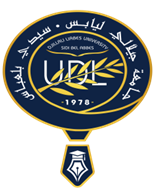Browsing by Author "MEHDAOUI Lakhdar"
Error fetching items

Institutional Repository of the Djillali Liabes University of Sidi Bel Abbes
All Rights Reserved. 2023 © UNIVERSITY OF Djilali Liabes
BP 89, Sidi Bel Abbes, 22000-Algeria .
PLATFORM DEVELOPED BY DSPACE LYRASIS.